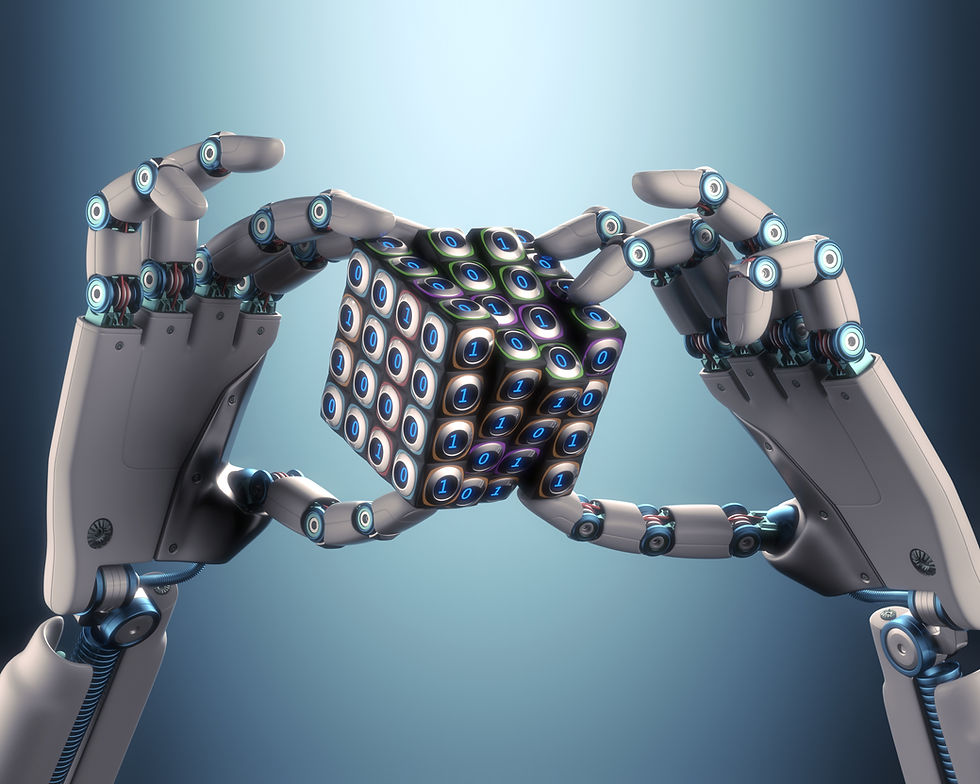AI: The question mark hanging over the modern workplace
- info3686918
- Oct 21
- 4 min read

Welcome back to Holla HR! If you’re new here — welcome! 👋 Our blog explores all sorts of HR and coaching-related topics, written by real professionals with over 20 years’ experience supporting SMEs.
If you’d like to stay in the loop, make sure to sign up to our mailing list so you don’t miss any updates — we’d love to have you!
AI: The question mark hanging over the modern workplace
Today we’re tackling a huge question that’s on everyone’s mind — not just in HR, but across every industry: Artificial Intelligence.
If you’ve been wondering what all the AI talk really means for your workplace, you’re not alone — so let’s get into it.
AI is everywhere (and it’s here to stay)
From writing emails to screening candidates, AI is reshaping how we work.
It’s not just for tech giants anymore — everyday tools like Microsoft 365 and Google are constantly developing and introducing new built-in AI features that help automate tasks and save time.
Recruitment software can scan CVs in seconds. Chatbots can handle basic HR queries. But these tools also raise new challenges around transparency, fairness, and trust.
Trust matters more than ever
As AI becomes part of everyday work, trust matters more than ever. Employees need to feel confident that automation and algorithms are being used to support them — not to monitor or replace them.
That’s where HR plays a crucial role. Clear communication about how AI tools are used, what data they collect, and how decisions are made is essential for building transparency. When people understand the “why” behind the tech, they’re far more likely to embrace it.
It’s also about ethics. HR teams must ensure AI systems are fair, inclusive, and free from bias — especially in recruitment and performance management. That means regularly reviewing algorithms, questioning results, and maintaining a human perspective in every decision.
The main takeaway? As powerful as AI is, it should be used as a tool, not a replacement — the human aspect is more important than ever.
Supporting people through change
Someone said to me just last week, “My job won’t exist in five years.”
AI can be a powerful tool for productivity, but it can also bring uncertainty. Leaders can help by reframing AI as a collaborator, not a competitor — and by providing training and upskilling to help employees adapt and feel empowered, rather than threatened.
This is where Holla HR can make a real difference — offering tailored coaching and people strategies that help your teams grow with change, not fear it.
Creating a culture of continuous learning — where people are encouraged to experiment, ask questions, and develop new skills — helps everyone see AI as a way to enhance their work, not replace it.
And honestly? We don’t see AI ever being able to fully replace sectors like HR — where empathy, flexibility, and human connection are at the heart of everything we do.
How HR Can Lead the Way
HR has always been about people — and that’s not changing. But what is changing is how people and technology work together.
AI can’t replace empathy, coaching, or connection — but it can enhance how we do these things. By freeing up time spent on admin tasks or data entry, HR professionals can focus more on what really matters: supporting people, developing culture, and driving meaningful change.
HR is also uniquely positioned to lead conversations about AI ethics, data privacy, and inclusion. Whether it’s reviewing recruitment tools for bias, setting policies for responsible AI use, or simply encouraging open dialogue about change — HR can set the tone for how organisations approach this new era.
By leading with transparency and trust, HR teams can ensure AI is adopted in a way that truly benefits everyone — not just the business.
5 Ways to Use AI Responsibly and Effectively in Your Organisation
Be transparent about AI use
Let your people know when and how AI is being used — especially in processes like recruitment, data analysis, or performance tracking. Clarity builds trust and reduces fear.
Keep humans in the loop
AI should support decisions, not make them alone. Always include human input and oversight in key areas to maintain fairness, empathy, and context.
Review and monitor regularly
AI tools evolve — and so should your approach. Regularly check for bias, accuracy, and unintended consequences to make sure technology stays fair and ethical.
Invest in learning and development
Encourage teams to learn how to use AI tools effectively. Training not only builds confidence but helps employees see AI as a partner, not a threat.
Lead by example
Leadership sets the tone for how an organisation uses AI. Model responsible behaviour by balancing innovation with transparency, empathy, and inclusion.
By following these principles, businesses can confidently harness AI’s potential while protecting what matters most — their people.
Let’s shape the future of work, together
Curious how your organisation can embrace AI while keeping people at the centre?
💬 Get in touch with Holla HR — we help businesses build trust, empower teams, and lead the future of work responsibly.
.png)



Comments